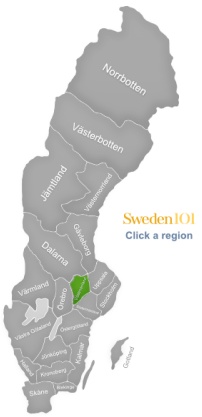Västmanland - Färnebofjärden National Park, Engelsberg Iron Works, Västerås, Anundshög, Norberg
0 Västmanland Diaspora around the world
Our in-person family gatherings
Ireland's President Higgins family message
Our TEDx talk about family gatherings

What does the name of the region mean?
The region's name can be translated as the land of the Western men.
What is the region's historical importance?
The region was an important center for the production of iron in the past.
What is the region known for?
The region is known for some rather different things: The largest burial mound in Sweden can be found just outside the region's capital Västerås. Västerås is also known as the cucumber capital because so many cucumbers very successfully grown during the 18th and 19th century. The capital still has to live with that nickname today. Västerås is also home to Sweden's oldest gymnasium (secondary school), and Sweden's highest cocktail bar which is located in a skyscraper. The capital also tries to make itself more attractive to tourists and tries to be seen as something else but just an industrial city.
The region is also known for the biggest electrical music festival in Scandinavia which takes place in Norberg, in an old mine.
Even though the main focus in this region is on various industries, it can still be a very interesting place for people who would like to learn more about history and heritage, and also for people who would like to explore some interesting natural areas.
What are some places you need to visit in Västmanland?
Färnebofjärden National Park
This national park includes a forest that was once exploited for the running of the mines in the region, but it has been awarded a protective status since 1998. Today, the Färnebofjärden National Park is very popular with visitors which often choose to explore the park via the river that runs through it. However, there is also a network of good paths that allows people to explore the park on foot. There are also extraction sites that can be found in the park and which speak of how people in the iron age used the resources of this forest.
Engelsberg Iron Works
The Engelsberg Iron Works are a UNESCO world heritage site, and have been built in 1681. During the 19th century, these iron works were one of the world's most modern iron works of that period. While the Engelberg Iron Works are not active any more these days, there count as one of the best preserved examples of this kind of iron works, and are worth a visit to learn more about that particular part in Sweden's history.
Västerås (yes, people make references to the Westeros of Game of Thrones all the time)
Västerås is the capital of the region, is home to around 111,000 people, and one of the oldest cities in Sweden. In this city, you can sit in Sweden's highest cocktail bar after visiting the historic cathedral and some of the other sites of historical interest. You could also take a boat tour on the lake, and learn more about Sweden's history by visiting a museum.
Anundshög
This large Swedish burial mound can be easily visited while you are in Västerås as it is only just a little distance outside the city. This burial mound is the largest you can find in Sweden and dates back to the time around 500 AD.
Norberg
Norberg was one of the most important center for the iron trade, and the iron mining in the region around Norberg can be traced back to 500 AD. In the Middle Ages, the town was used as a place to gather and trade by the men from the surrounding mountains. Today, people can visit the old mines (there is even a music festival in there every year). There has been a fire during the 18th century that destroyed a lot of the town, but the basic plan of the original town can still be seen today.

_(2).jpg)